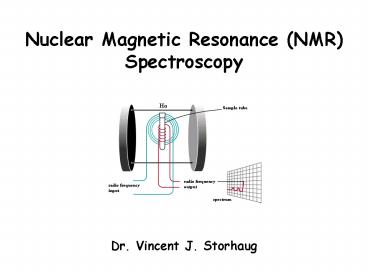Nuclear Magnetic Resonance (NMR) Spectroscopy - PowerPoint PPT Presentation
1 / 31
Title:
Nuclear Magnetic Resonance (NMR) Spectroscopy
Description:
Nuclear Magnetic Resonance (NMR) Spectroscopy Dr. Vincent J. Storhaug Deuterated Solvent Signals in 13C NMR Spectra Why do you see this as a triplet at 77 ppm? – PowerPoint PPT presentation
Number of Views:201
Avg rating:3.0/5.0
Title: Nuclear Magnetic Resonance (NMR) Spectroscopy
1
Nuclear Magnetic Resonance (NMR) Spectroscopy
Dr. Vincent J. Storhaug
2
Deuterated Solvent Signals in 13C NMR Spectra
Why do you see this as a triplet at 77
ppm? 1JCD 45 Hz n number of nuclei I spin
quantum number What do you expect the
multiplicity to be for Acetone-d6 (C3D6O)?
3
90º Pulse Calibration Off Resonance
Resonance Line
Transmitter Frequency
4
Advantages to Using Higher Applied Fields
60 MHz propyl bromide
300 MHz propyl bromide
5
Advanced NMR Experiments
Advanced NMR Experiments
Two Dimensional
Homonuclear 1H-1H Correlation
Heteronuclear 13C-1H, 15N-1H, 13C-15N Correlation
One Dimensional
1-Channel
2-Channel
Solvent Suppression HOMODEC NOEDIF
DEPT INEPT
6
The Problem Solvent Signal or an Undesired HOD
Signal is Flooding the Sample
7
A Situation Where RECEIVER GAIN Doesnt Work to
Your Advantage
8
The Problem Solvent Signal or an Undesired HOD
Signal is Flooding the Sample
9
A Situation Where RECEIVER GAIN Doesnt Work to
Your Advantage
10
Solvent Suppression
Three commonly used techniques Using the
Decoupler to provide Presaturation (Good) Using
a Series of Pulses to provide Presaturation
(Better) Using Pulse Sequences involving the
Gradients (Best) Set up the experiment the same
as a homodec experiment homonuclear
decoupling. Changes the experiment from a
one-pulse experiment to a two-pulse experiment.
11
One-Channel Two-Pulse Sequence
n
y
n
d1 delay 1
at acquisition time
d2 delay 2
pw2
pw1
time
0 s (more if needed)
2 s
12
(No Transcript)
13
(No Transcript)
14
Homonuclear Decoupling Experiment
n
y
n
d1 delay 1
at acquisition time
d2 delay 2
pw2
pw1
time
0 s
5T1
15
Homonuclear Decoupling Experiment
1
3
5
7
16
Homonuclear Decoupling Experiment
1
3
5
7
17
Homonuclear Decoupling Experiment
1
3
5
7
18
Homonuclear Decoupling Experiment
1
3
5
7
19
Homonuclear Decoupling Experiment
1
3
5
7
20
Homonuclear Decoupling Experiment
1
3
5
7
21
HOMODEC Experiment Ethyl Crotonate
Expanded 1H spectrum for ethyl crotonate. (a)
Control spectrum. (b) Spectrum with 4-Me group
irradiated. (c) Spectrum with H-2 irradiated.
22
NOEDIF Experiment
The Nuclear Overhauser Effect is a net change of
the signal intensity of one spin due to the
relaxation of a saturated spin that is
dipole-dipole coupled to the first spin. An NOE
may be positive OR negative (the latter is more
common for large molecules) NOEs develop
through space rather than through bonds (i.e.
through dipole-dipole interactions and not
through J coupling) T1 is the key! Fluctuating
fields are good, tumbling and molecules are bad.
23
(No Transcript)
24
(No Transcript)
25
2D NMR Acronymns
NOESY NOE Spectroscopy ROESY Rotating-Frame
NOE Spectroscopy COSY Correlation
Spectroscopy TOCSY Total Correlation
Spectroscopy HETCOR Heteronuclear
Correlation Long Range HETCOR Long Range
Heteronuclear Correlation COLOC Correlation
through Long-Range Coupling HSQC Heteronuclear
Single Quantum Correlation HMBC Heteronuclear
Multiple-Bond Correlation EXSY Exchange
Spectroscopy APT Attached Proton Test Solvent
Suppression Methods WATERGATE Water Suppression
Through Gradient Tailored Excitation
SECSY Spin Echo Correlated Spectroscopy DANTE
Delay Alternating with Nutation for Tailored
Excitation CHESS Chemical Shift Selective
Imaging Sequence INADEQUATE Incredible Natural
Abundance Double Quantum Transfer Experiment D
UMBO Decoupling Using Mind Boggling
Optimization GROPE Generalized Compensation
for Resonance Offset and Pulse Length
Errors DOUBTFUL Double Quantum Transitions
for Finding Unresolved Lines
26
13C NMR - DEPT(Distortionless Enhancement of
Polarization Transfer)
multpw90
pw90
pw90
Dec pw90
pw90
pw90
pw90
mult is an arrayed parameter (0.5, 1, 1, 1.5)
that leads to a value for the ? pulse of multpp
mult0.5 (? 45) gives approximately equal
excitation of all protonated carbons mult1.0 (?
90) excites CHs only (or mainly) mult1.5 (?
135) gives CHs, CH3s up, CH2s down. dm
(decoupler modulation) is set to 'nny'.
27
13C NMR - DEPT(Distortionless Enhancement of
Polarization Transfer)
In a DEPT135 experiment -CH3 and CH peaks
appear as normal -CH2- peaks appear
inverted Quaternary C are not usually seen This
way the number of H attached to C can usually be
deduced. Standard 13C NMR Spectrum of
ethylbenzene
28
13C NMR - DEPT(Distortionless Enhancement of
Polarization Transfer)
In a DEPT135 experiment -CH3 and CH peaks
appear as normal -CH2- peaks appear
inverted Quaternary C are not usually seen This
way the number of H attached to C can usually be
deduced. Standard 13C NMR Spectrum of
ethylbenzene
29
DEPT-45 DEPT-90 DEPT-135
C 0 0 0
CH
CH2 0 -
CH3 0
30
DEPT 135
31
DEPT 90
DEPT 135































